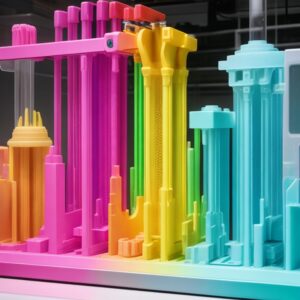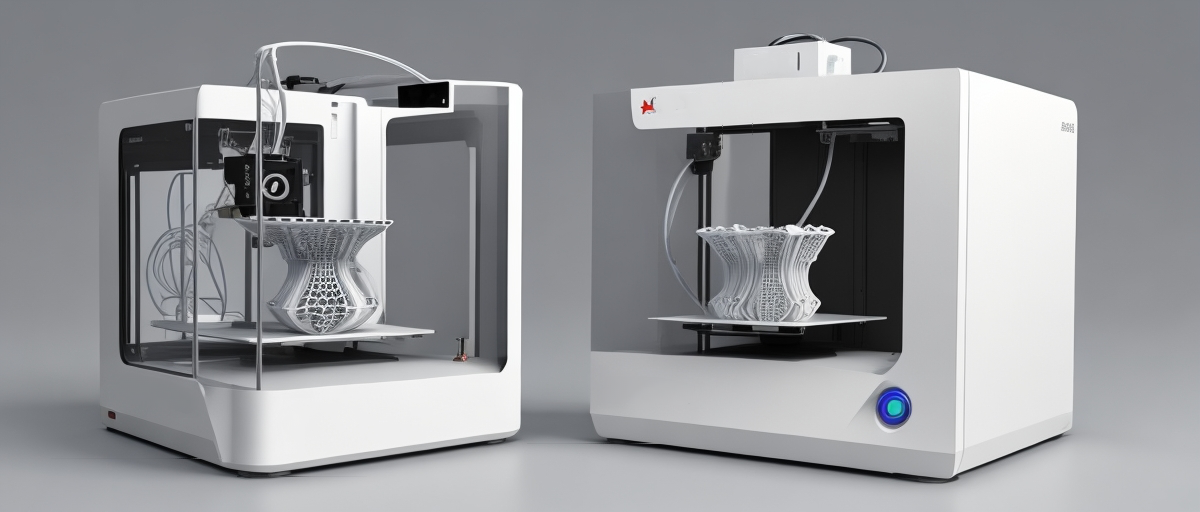 Full-color 3D printing marks a leap from the traditional monochromatic printing methods that laid the foundation of the 3D printing industry. Full-color 3D printing it’s about bringing to life a digital model with the full spectrum of color one would expect to see in the real world. This exciting capability enables the creation of objects with a richness and depth of color that closely mirrors the original design intent, producing results that are compelling in visual fidelity.
Full-color 3D printing marks a leap from the traditional monochromatic printing methods that laid the foundation of the 3D printing industry. Full-color 3D printing it’s about bringing to life a digital model with the full spectrum of color one would expect to see in the real world. This exciting capability enables the creation of objects with a richness and depth of color that closely mirrors the original design intent, producing results that are compelling in visual fidelity.
The intricacies of full-color printing technology involve a process of depositing colored material in precise locations, layer by layer, according to the digital blueprint. The color is integrated throughout the object, ensuring that the hues are inherent to the material itself. This results in a robust and seamless integration of color, where the vibrancy and color accuracy are maintained even when the object is viewed from different angles or under varying lighting conditions.
Contrast this with traditional monochromatic 3D printing, where the entire object is produced in a single color, typically determined by the color of the material used. Any additional hues required post-processing painting or dying, which could be labor-intensive and imprecise. A full-color 3D printed object, in comparison, comes out of the printer with the desired color scheme already in place. This saves time and labor and opens up an entirely new dialogue between design and execution where color becomes an integral part of the design process from the very start.
To achieve full-color capabilities, several technological approaches have been developed, each with its unique mechanisms for incorporating color into the 3D printing process. These methods vary in terms of the materials they use, the resolution they can achieve, and the complexity of color control they allow. Among them, we find processes like Material Jetting, ColorJet Printing, and Binder Jetting, which have pioneered the way towards achieving vibrant, multi-colored objects with finishes that closely resemble those found in mass-produced items.
Integral to the success of full-color 3D printing is the symbiotic relationship between the hardware that physically lays down the material and the software that dictates how and where color is applied. Advanced software algorithms calculate the dimensions and structure of the object and how the combinations of base colors will blend to produce the desired final palette. Precision in this digital processing ensures that each printed layer contains exactly the right arrangement of colors, which, when combined, render the full-color object in staggering detail.
In blurring the lines between reality and reproduction, full-color 3D printing demands a reimagining of what 3D printing technology can achieve. It bridges the gap between the tangible and the virtual, allowing for the faithful recreation of artifacts as seen in their original environments. For artists, designers, engineers, and manufacturers, the impact of full-color 3D printing is profound, providing a means to represent their visions faithfully and doing so with a vibrance and precision that had until recently, been the sole province of dreams and digital screens.
Technologies Enabling Full-Color 3D Printing
At the heart of the full-color 3D printing revolution lies a selection of innovative technologies, each contributing to the vibrant tapestry of possibilities in additive manufacturing. Material Jetting (MJ), ColorJet Printing (CJP), and Binder Jetting are three methods that have significantly pushed the boundaries of what can be achieved with 3D printing in terms of color and material diversity.
Material Jetting is akin to the process used by standard inkjet printers but adapted for 3D printing. This technique involves jetting droplets of photopolymer material onto a build platform. Each droplet is instantly cured and solidified by ultraviolet (UV) light. What sets MJ apart in the realm of full-color printing is its ability to simultaneously jet and cure different colored materials. With MJ, a base material is mixed with colored inks, and the dedicated jets can deposit multiple photopolymer droplets that blend seamlessly, creating gradient transitions and a broad spectrum of colors. High precision is a hallmark of this technology, as it can create layers as thin as several micrometers, allowing for detailed textures and smooth surfaces that are visually striking and tactically impressive.
ColorJet Printing is distinguished by its unique use of a powdery substance – commonly a gypsum-like material – as the base for its prints. In CJP, a print head passes over a thin layer of this powder, selectively dispensing a colored binder solution that acts as both a glue and a pigment. The binder bonds the powder particles in designated areas, creating each cross-sectional layer of the object in full color as the build platform gradually descends. Subsequent layers of powder are spread over the build area, and the process repeats until the item is fully formed. CJP excels in its ability to produce rich, full-spectrum color prints and is particularly useful for creating models and prototypes that require a visual impact to communicate design intentions effectively.
Binder Jetting shares similarities with CJP in that it also utilizes a powder base and a liquid binding agent. The critical difference is in the material versatility it offers. Beyond powdered gypsum, Binder Jetting can work with a variety of other materials, such as metals, sand, and ceramics, making it an increasingly popular choice for functional parts as well as full-color models. The process involves spreading a layer of powder, followed by selectively jetting a binder onto the powder layer where the cross-section of the part is to be created. The process repeats, layer by layer, until the object is completed. Upon completion, the excess powder is removed, revealing the full-color object. For full-color applications, the binder can be mixed with pigments, enabling a wide range of colors to be applied during the printing process. This technology is particularly adept at creating complex geometries and large parts with a remarkable degree of design freedom.
Materials Used in Full-Color 3D Printing
Gypsum-based powders offer a significant medium in full-color printing. These fine, granular substances form the bedrock of ColorJet Printing (CJP) technologies. When deposited layer by layer and infiltrated with a colored binding agent, they can yield models with vivid colors and fine details. The porous texture and matte finish of gypsum models give them an attractive, stone-like quality that appeals to a broad range of users, from architects creating scaled models to consumer applications where aesthetic appeal is paramount.
Ceramics have emerged as an innovative choice for full-color 3D printing, bringing with them new opportunities for customization and creativity. When blended with colorants, ceramic materials can be used to create decorative items, tableware, or intricate art pieces that are both visually striking and functional. The inherent heat resistance and durability of ceramics make them suitable for objects that need to withstand high temperatures or wear and tear, providing a practical as well as an aesthetic dimension to the printed outputs.
A jump forward has been the advent of multi-material printing, which unlocks the potential to print parts comprising different materials within a single print cycle. This technological leap enables the fabrication of objects with varying textures, densities, and mechanical properties, expanding the realm of functional full-color prototypes and end-use products.
Despite this material diversity and the inherent promise it brings, several challenges remain to be addressed in full-color 3D printing. One of concerns is color durability. The vibrancy and clarity of colors over time can be affected by exposure to sunlight and other environmental factors, leading to discoloration or fading. Advances in material science are looking at ways to enhance the UV resistance of these materials to maintain long-lasting color fidelity.
Translucency in materials also presents exciting but complex possibilities. Adjusting the opacity of materials to allow light penetration at varying degrees expands the visual dynamics of a piece but also adds complexity to the printing process. Managing the interplay of light and color is a delicate balance, especially when striving to achieve a specific effect or depth of color.
Full-color prints, particularly those made from powders or resins, are often not as robust as their monochrome counterparts made of sturdier plastics or metals. While full-color 3D printed parts excel in their visual appeal, they may not always be suitable for applications requiring high mechanical strength. Ongoing research into material treatments such as infiltrants and coatings aims to bolster the structural integrity of these prints.

